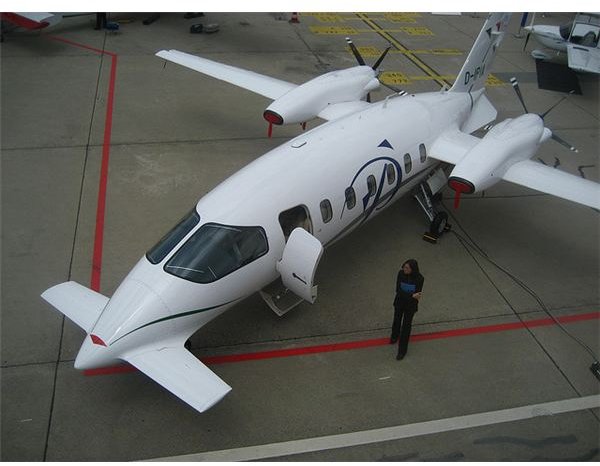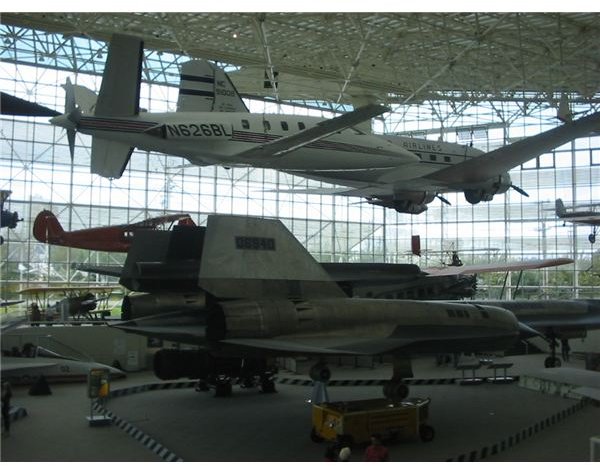Jet Aircraft with Propellers on the Rear of the Engines
Turboprop Pusher Aircraft
In aircraft terminology, a jet engine providing thrust by spinning a propeller is called a turboprop. A jet aircraft with propellers on the rear of the engines would be called turboprop pusher aircraft. The more common use of propeller propulsion is to have the propeller in front of the engine – piston or turbine. Putting the propeller to the rear is called a pusher configuration.
The Wikipedia category listing for “Pusher Aircraft” produces 199 pages of airplanes. The majority of these planes hail from the eras of World War I and II or fit in the category of kit aircraft. Modern, commercial use pusher aircraft are rare and the list drops to just a few when the requirement of turbine power is added. The short list includes some sleek, almost futuristic looking airplanes!
Lear Fan 2100
Bill Lear, the founder of Lear Jet and one of the companies that started the business jet segment, spent many years working on the Lear Fan 2100. The Lear Fan pioneered the use of composites in commercial aircraft, which benefited the planes listed below. The Lear Fan first flew in January 1981.
Design features of the Lear Fan start at the rear with the “Y” shape tail in front of the single four-blade propeller. The two turbine engines are mounted on the fuselage and both were connected to the single prop through separate drive shafts. This setup allowed the Lear Fan to have two engine power and reliability and maintain flight characteristics in single engine mode. Lift was provide by a straight wing with a very thin aspect ratio.
Beech Starship

The Beech Starship 2000 reached commercial production and about 50 of this futuristic plane were produced. The Starship was designed by Burt Rutan and also featured extensive use of composite materials. The first Starship flew in 1986 and commercial production began in 1988. The airplane was produced until 1995 and Beechcraft ceased support of the plane in 2003, destroying or scrapping most of the remaining Starships.
Besides the twin turboprop pusher engines, the Starship has a striking design. The swept wing is set well back on the fuselage with small forward canards for stability. The aircraft does not have a rudder, and rudder function was provided by the upright wingtips.
Piaggio Avanti

The Piaggio P180 Avanti II is the one pusher turboprop commercial jet currently in production and use. The Avanti mirrors the canard design of the Beech Starship with a straight wing a more traditional T-tail. The P180 Avanti entered service in 1990 and the first Avanti II was delivered to the customer in 2005. Over 200 of the two Avanti models have been produced.
The Avanti II cruises at 0.7 mach, excellent speed for a turboprop powered aircraft, and it can travel at an altitude of 41,000 feet. The plane is certified for single pilot operations. The cabin is pressurized and typical seating is for five passengers. The Avanti II has a range of almost 2,000 miles. With a top cruise speed of 400 knots, the Avanti is significantly faster than most conventional turboprop aircraft. Asking price for a new P180 Avanti II is in the neighborhood of $6.2 million.
The list of jet aircraft with propellers on the rear of the engines is small, with only one plane, the Avanti II, currently in production. Yet these planes were all ahead of their time, providing platforms for new aircraft materials and aerodynamic shapes.
References
Museum of Flight, https://www.museumofflight.org/
Robert Sherer’s Beachcraft Starship Material, https://rps3.com/Pages/Starship.htm
Pilot Friend, https://www.pilotfriend.com/
Aerospacetechnology.com, https://www.aerospace-technology.com/projects/piaggio/
General Aviation Services, https://www.genav.com/Default.html
Image Credits: Flickr Creative Commons Attribution / Blll Abbott / Armchair Aviator / nickgraywfu
